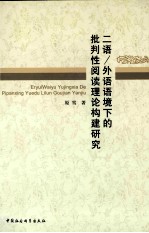

二语外语语境下的批判性阅读理论构建研究 英文PDF电子书下载
- 电子书积分:11 积分如何计算积分?
- 作 者:原雪著
- 出 版 社:北京:中国社会科学出版社
- 出版年份:2013
- ISBN:9787516135440
- 页数:255 页
Chapter 1 Introduction 1
1.1 Origins of the Study 1
1.2 The Rationale of the Study 3
1.3 Aims and Objectives of the Study 11
1.4 The Organization of the Dissertation 12
Chapter 2 Literature Review 15
2.1 Introduction 15
2.2 Historical Context of Globalization 16
2.3 Philosophical Foundations 17
2.3.1 Critical Theory 17
2.3.2 Deconstructionism 19
2.3.3 Post Colonialism 21
2.3.4 Summary 27
2.4 Brief Overview of ESL/EFL Reading Research 28
2.4.1 ESL/EFL Reading Research Prior to the 1970s 28
2.4.2 ESL/EFL Reading Research after the 1970s 30
2.4.3 Summary 38
2.5 Brief Overview of Critical Reading Research Abroad and at Home 39
2.5.1 Critical Reading Research Abroad 39
2.5.2 Critical Reading Research at Home 40
2.5.3 Summary 43
Chapter 3 Theoretical Preliminaries 45
3.1 Introduction 45
3.2 Theoretical Foundations for This Study 46
3.2.1 Critical Discourse Analysis 46
3.2.2 Theories of Dialogisms 55
3.2.3 Critical Pedagogy 63
3.2.4 Summary 65
3.3 Defining the Key Concepts 65
3.3.1 Critical Reading/Critical Literacy 66
3.3.2 Discourse or Text 72
3.3.3 Ideology 77
3.3.4 Being Critical 82
3.3.5 Summary 85
Chapter 4 Contrastive Rhetoric and Ideology 87
4.1 Introduction 87
4.2 Literacy and Power 88
4.2.1 Defning Literacy 88
4.2.2 Social Construction of Meaning 89
4.2.3 Ideology as a Conceptual Link between Discourse and Power 90
4.2.4 Summary 94
4.3 Cognitive Vs.Social 94
4.3.1 The Motivation of Reading's Cognitive Perspective 94
4.3.2 Reading as a Social Process 97
4.3.3 Reading in Critical Context 102
4.4 Contrastive Rhetoric and Cross-Cultural Nature of Reading in ESL/EFL Context 106
4.4.1 Traditional Contrastive Rhetoric 107
4.4.2 New Contrastive Rhetoric 108
4.4.3 Contrastive Rhetoric's Role in Critical Reading 112
4.4.4 Summary 113
4.5 Reading in Native Context and Reading in ESL/EFL Context 114
4.5.1 Reading in Native Context 115
4.5.2 Reading in ESI/EFL Context 116
4.5.3 Differences of Reading in Native Context and in ESL/EFL Context 118
4.5.4 The Specific Language Socialization for the Readers in ESL/EFL Context 122
4.5.5 Summary 124
Chapter 5 Building the Text Representation in ESL/EFL Context 125
5.1 Introduction 125
5.2 Synthetical Process of"Meaningfulness" 126
5.2.1 Proposition:Ideal Representation of the Text 127
5.2.2 Dynamic Levels of"Meaningfulness" 132
5.3 Filling the Conceptual Gap through Inferences 134
5.3.1 Building Coherence through Explicit Node 134
5.3.2 Filling the Conceptual Gap by Inferences 137
5.4 Overreliance of Text Representation Building in ESL/EFL Context 145
5.4.1 Knowledge of Text Structure 145
5.4.2 Text Structure's Function in Comprehension 148
5.4.3 Language Cultural Schemata in ESL/EFL Context 151
5.5 Building Text Representation in ESL/EFL Context 158
5.5.1 Situation-Model Building in ESL/EFL Context 158
5.5.2 Determinacy State and Language Familiarity 164
5.5.3 Summary 166
Chapter 6 The Process of De-Idealization by Reader 168
6.1 Introduction 168
6.2 Idealization by Attitudinal Parameter 169
6.2.1 Attitudinal Resources in Discourse 169
6.2.2 Idealization through Inscribed Attitudinal Values 184
6.2.3 Idealization by Evoked Values 198
6.2.4 Idealization by Topicalization 203
6.2.5 Idealization by Announcement 207
6.3 Summary 210
7.1 Major Findings of This Study 211
7.2 Pedagogical Implications 213
Bibliography 217
Appendix 242
- 《批判 建构与实践 戴维·佩珀生态社会主义思想研究》梅丽著 2019
- 《学校教育指标系统的构建》杨向东著 2019
- 《中国二氧化碳减排和环境协同效益评价模型的构建与研究》杨曦,滕飞著 2019
- 《商务英语写作中批判性同伴反馈教学理论与实践》刘晓庆责任编辑;高现伟 2019
- 《易人外语 英语考试必备单词全收录 高级篇》李维,强森 2019
- 《辩方权利的语境式展开》黄琳佳责任编辑;(中国)王天民 2019
- 《磁性核壳结构吸波材料构建与制备》刘渊,陈桂明,王炜著 2019
- 《地方文化特色历史课堂与学科体系的构建》刘金林,聂亚珍 2019
- 《“一带一路”倡议下中国城市形象与城市文化的构建》李莹著 2019
- 《黑格尔的自由主义批判》(美)史蒂芬·B.史密斯(StevenB.Smith) 2019
- 《沧州地域民间工艺美术实录》王雪著 2016
- 《恋恋晚风沉》千雪著 2020
- 《怪谈百物语 暗兽》(日)宫部美雪著 2019
- 《幻色江户怪谈》(日)宫部美雪著 2019
- 《奋斗着 就这样考进清华》张晓卉,肖映雪著 2018
- 《中国玉文化与系统宝石学丛书 贵州罗甸玉研究》廖宗廷,支颖雪著 2017
- 《天诛玉 下》灵雪著 2013
- 《岚城千夜》灵雪著 2012
- 《把苦日子过甜 生活处处有哲学》穆雪著 2013
- 《天诛玉 上》灵雪著 2013
- 《红色旅游的社会效应研究》吴春焕著 2019
- 《中国当代乡土小说文库 本乡本土》(中国)刘玉堂 2019
- 《社会学与人类生活 社会问题解析 第11版》(美)James M. Henslin(詹姆斯·M. 汉斯林) 2019
- 《异质性条件下技术创新最优市场结构研究 以中国高技术产业为例》千慧雄 2019
- 《中国铁路人 第三届现实主义网络文学征文大赛一等奖》恒传录著 2019
- 《莼江曲谱 2 中国昆曲博物馆藏稀见昆剧手抄曲谱汇编之一》郭腊梅主编;孙伊婷副主编;孙文明,孙伊婷编委;中国昆曲博物馆编 2018
- 《中国制造业绿色供应链发展研究报告》中国电子信息产业发展研究院 2019
- 《中国陈设艺术史》赵囡囡著 2019
- 《指向核心素养 北京十一学校名师教学设计 英语 七年级 上 配人教版》周志英总主编 2019
- 《《走近科学》精选丛书 中国UFO悬案调查》郭之文 2019
